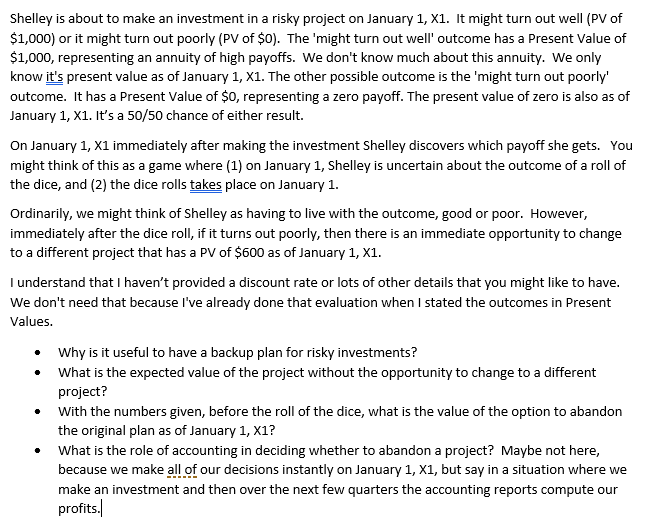
Shelley is about to make an investment in a risky project on January 1, X1. It might turn out well (PV of $1,000) or it might turn out poorly (PV of $0). The 'might turn out well' outcome has a Present Value of $1,000, representing an annuity of high payoffs. We don't know much about this annuity. We only know it's present value as of January 1, X1. The other possible outcome is the 'might turn out poorly' outcome. It has a Present Value of $0, representing a zero payoff. The present value of zero is also as of January 1, X1. It's a 50/50 chance of either result. On January 1, X1 immediately after making the investment Shelley discovers which payoff she gets. You might think of this as a game where (1) on January 1, Shelley is uncertain about the outcome of a roll of the dice, and (2) the dice rolls takes place on January 1. Ordinarily, we might think of Shelley as having to live with the outcome, good or poor. However, immediately after the dice roll, if it turns out poorly, then there is an immediate opportunity to change to a different project that has a PV of $600 as of January 1, X1. I understand that I haven't provided a discount rate or lots of other details that you might like to have. We don't need that because I've already done that evaluation when I stated the outcomes in Present Values. Why is it useful to have a backup plan for risky investments? What is the expected value of the project without the opportunity to change to a different project? With the numbers given, before the roll of the dice, what is the value of the option to abandon the original plan as of January 1, X1? What is the role of accounting in deciding whether to abandon a project? Maybe not here, because we make all of our decisions instantly on January 1, X1, but say in a situation where we make an investment and then over the next few quarters the accounting reports compute our profits. Shelley is about to make an investment in a risky project on January 1, X1. It might turn out well (PV of $1,000) or it might turn out poorly (PV of $0). The 'might turn out well' outcome has a Present Value of $1,000, representing an annuity of high payoffs. We don't know much about this annuity. We only know it's present value as of January 1, X1. The other possible outcome is the 'might turn out poorly' outcome. It has a Present Value of $0, representing a zero payoff. The present value of zero is also as of January 1, X1. It's a 50/50 chance of either result. On January 1, X1 immediately after making the investment Shelley discovers which payoff she gets. You might think of this as a game where (1) on January 1, Shelley is uncertain about the outcome of a roll of the dice, and (2) the dice rolls takes place on January 1. Ordinarily, we might think of Shelley as having to live with the outcome, good or poor. However, immediately after the dice roll, if it turns out poorly, then there is an immediate opportunity to change to a different project that has a PV of $600 as of January 1, X1. I understand that I haven't provided a discount rate or lots of other details that you might like to have. We don't need that because I've already done that evaluation when I stated the outcomes in Present Values. Why is it useful to have a backup plan for risky investments? What is the expected value of the project without the opportunity to change to a different project? With the numbers given, before the roll of the dice, what is the value of the option to abandon the original plan as of January 1, X1? What is the role of accounting in deciding whether to abandon a project? Maybe not here, because we make all of our decisions instantly on January 1, X1, but say in a situation where we make an investment and then over the next few quarters the accounting reports compute our profits







